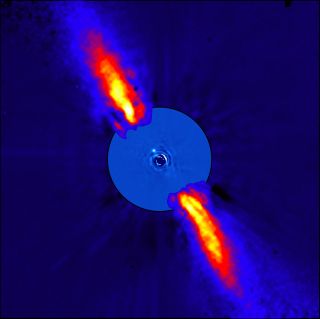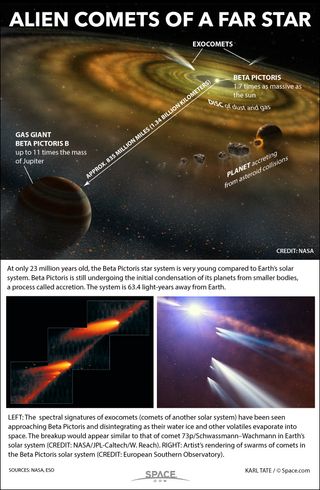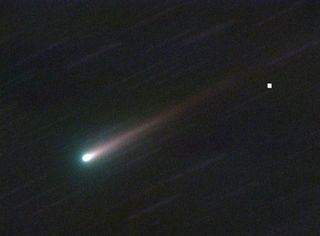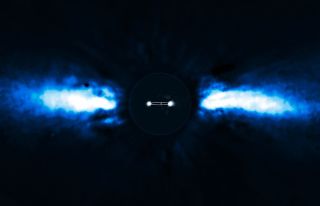Hundreds of 'Exocomets' Around Nearby Star Come in Two Flavors
The best look yet at nearly 500 comets around a distant star reveals these alien snowballs come in very different flavors, just like comets around the sun, researchers say.
The discovery of these distant "exocomets" could shed light on what the solar system was like in its tumultuous youth, scientists added.
In the past 20 years or so, researchers have confirmed the existence of more than 1,700 exoplanets, or worlds circling distant stars. Recently, scientists have begun detecting alien comets as well. Comets are icy bodies that give birth to giant tails of gas and dust when they approach stars. [Alien Comets of Beta Pictoris Explained (Infographic)]

Astronomers investigated Beta Pictoris, a relatively young star located about 63 light-years from the sun. At only about 20 million years of age — far younger than the 4.6-billion-year-old sun — Beta Pictoris is surrounded by a huge protoplanetary disk. A disk of gas and dust just like this one encircled the sun in its youth.
For nearly 30 years, scientists have detected subtle changes in the light from Beta Pictoris that researchers thought were caused by exocomets traveling in front of the star. This is because the gas and dust from comets can absorb some of the light passing through them.
To study these exocomets around Beta Pictoris, the research team examined more than 1,000 observations gathered between 2003 and 2011 with the HARPS (High Accuracy Radial velocity Planet Searcher) instrument on the European Southern Observatory's 3.6-meter (11.8 feet) telescope at the La Silla Observatory in Chile. They analyzed the orbits of 493 different exocomets.


The scientists discovered two very different families of exocomets around Beta Pictoris. One is apparently old and under the gravitational sway of a giant planet in the system, while the other is apparently young and the result of a recent breakup of far larger objects. Different families of comets also exist in the solar system.
Get the Space.com Newsletter
Breaking space news, the latest updates on rocket launches, skywatching events and more!
The first group of exocomets generated relatively low amounts of gas and dust, suggesting they're old enough to have mostly exhausted their supplies of ice during multiple passages close to their star. The shape and orientation of their orbits vary, but a giant planet seems to gravitationally influence all of them. This planet, Beta Pictoris b, orbits about 620 million miles (1 billion kilometers) from Beta Pictoris and was one of the first exoplanets that astronomers photographed directly.
The second family of exocomets generates far more gas and dust. These comets are also on nearly identical orbits to one another, suggesting they all have the same origin, probably as remnants of one or more larger icy objects that might have grazed the star Beta Pictoris. This makes the comets similar to the fragments of Comet Shoemaker-Levy 9, which collided spectacularly with Jupiter in 1994.
"Our study confirms that the evaporating bodies around Beta Pictoris are analogous to the comets in the [Earth's] solar system,"study lead author Flavien Kiefer, an astronomer at the Institute of Astrophysics of Paris in France and of Tel Aviv University in Israel,told Space.com.
"They are icy planetesimals, most probably the remnants of the processes which formed the planet Beta Pictoris b," Kiefer added. "Now they are pushed towards the star, maybe by Beta Pictoris b itself, and become star-grazing evaporating bodies, or comets. This is very similar to the action of Jupiter on the Kuiper Belt objects."


The Kuiper Belt is the ring of frigid objects beyond the orbit of Neptune. Pluto is the most famous of these faraway bodies.
The scientists said they expect to see similar cometary behavior in most, if not all, distant planetary systems younger than about 100 million years of age — when they can get a good look at the protoplanetary disks, Kiefer said.
"Our work shows that processes known to take place in the solar system also take place in young planetary systems," Kiefer said. "This reinforces the feeling that when looking to the Beta Pictoris and its environment, we are observing a somewhat younger version of our sun, when it was 10 million to 20 million years old and it just formed its planets."
The scientists plan to continue collecting data on Beta Pictoris using HARPS, which should shed light on how Beta Pictoris b influences cometary orbits, among other effects. The researchers detailed their findings in the Oct. 23 issue of the journal Nature.
Follow us @Spacedotcom, Facebook or Google+. Originally published on Space.com.
Join our Space Forums to keep talking space on the latest missions, night sky and more! And if you have a news tip, correction or comment, let us know at: community@space.com.

Charles Q. Choi is a contributing writer for Space.com and Live Science. He covers all things human origins and astronomy as well as physics, animals and general science topics. Charles has a Master of Arts degree from the University of Missouri-Columbia, School of Journalism and a Bachelor of Arts degree from the University of South Florida. Charles has visited every continent on Earth, drinking rancid yak butter tea in Lhasa, snorkeling with sea lions in the Galapagos and even climbing an iceberg in Antarctica. Visit him at http://www.sciwriter.us
Most Popular

